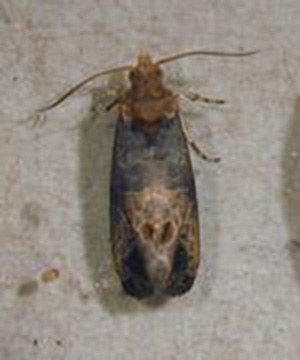Grape Berry Moth
ENTFACT-221: Grape Berry Moth | Download PDF
by Ric Bessin, Extension Specialist
University of Kentucky College of Agriculture
The grape berry moth is a key pest of grapes that is distributed in the United States east of the Rocky Mountains and causes serious damage to grapes in many states. The larvae of this insect damages commercial vineyards by feeding on the grape blossoms and berries. Infested berries may appear shriveled with fine webbing. Damage by grape berry moth may increase mold, rots and numbers of fruit flies. While grape berry moth larvae may only damage a few berries in a cluster, it is impractical for growers to remove damaged berries and webbing from clusters. Hosts include wild and cultivated grapes.

Figure 1. Adult GBM. Photo R. Isaacs, Michigan State University
The adult moth is small, active, and about 1/4 inch long. When it is at rest with its wings folded, there is a brown band across the middle of the insect, the hind portion is gray-blue with brown markings, while the front portion is gray-blue without markings.
The full grown larva is 2/5 inch long, pale olive-green, and can have a purplish tinge from the food it has eaten. The pupa is about 1/5 inch long, greenish-brown to dark brown and found under a flap cut in the leaf surface.
The grape berry moth overwinters as a pupa in leaf litter. Adults emerge in late May and lay eggs of the first generation singly on fruit stems near bloom time. Eggs hatch in about 5 days. Under a flimsy web, the larvae feed for about 21 days on the blossoms and young fruit. In mid July, larvae move to leaves where they make a semi-circular slit, fold the flap over themselves and pupate. Adult moths emerge from the pupae in 10 to 15 days. Moths begin laying eggs for the next generation after 4 to 5 days. There may be 2 or 3 generations per year. Larvae of the second and third generations enter berries and feed within, passing from one berry to another under protection of webbing. Some of the cocoons of the second or third generations fall to the ground where they overwinter.

Figure 2. Grape berry moth damage and webbing.
Webbing over blossoms and berries, and leaf flap cocoons are indicative of grape berry moth. In winter, the cocoons may be found in leaf litter under the vines.
Management
Clean up or bury leaf litter under vines in the winter to eliminate over wintering pupae. Although larvae first appear when the grapes are in bloom, insecticides should be applied when the berries are the size of small peas. Typically two applications, 10-days apart, are made to control the first generation. Insecticidal control of second generation is more difficult due to an extended flight period of moths as well as the difficulty of getting adequate spray coverage inside the cluster as berry size increases. Sprays for the second generation should be timed for the veraison stage of development. Pheromone traps are available to monitor for adult moth activity and enhance timing of insecticides for grape berry moth control.
Recent studies in some states have shown mating disruption with synthetic pheromones to be an effective alternative in situations where there is no immigration of moths from outside sources. Mating disruption relies on releasing enough of the pheromone in the vineyard so that males cannot find female moths. Eggs laid by unmated females fail to hatch. Various systems are commercially available for mating disruption of grape berry moth. Minimum orchard size may vary with the type of mating disruption used.
Revised: 11/19
CAUTION! Pesticide recommendations in this publication are registered for use in Kentucky, USA ONLY! The use of some products may not be legal in your state or country. Please check with your local county agent or regulatory official before using any pesticide mentioned in this publication.
Of course, ALWAYS READ AND FOLLOW LABEL DIRECTIONS FOR SAFE USE OF ANY PESTICIDE!
Photos courtesy Ric Bessin, University of Kentucky Entomology except Adult Grape Berry Moth: R. Isaacs, Michigan State University, used with permission.
